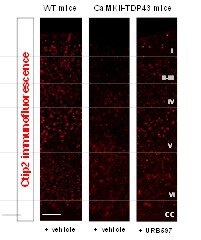Irene Santos‑García, Carmen Rodríguez‑Cueto, Patricia Villegas,..., Javier Fernández‑Ruiz, and Eva de Lago. Preclinical investigation in FAAH inhibition as a neuroprotective therapy for frontotemporal dementia using TDP-43 transgenic male mice
J Neuroinflammation. 2023
"Elevating the endocannabinoid tone may be beneficial in TDP-43-dependent FTD" – Dr. José Javier Fernández Ruiz and Dra. Eva de Lago Femia-
Summary:
- Background: Frontotemporal dementia (FTD) is a heterogeneous group of early onset and progressive neurodegenerative disorders, characterized by degeneration in the frontal and temporal lobes, which causes deterioration in cognition, personality, social behavior and language. Around 45% of the cases are characterized by the presence of aggregates of the RNA-binding protein TDP-43.
- Methods: In this study, we have used a murine model of FTD that overexpresses this protein exclusively in the forebrain (under the control of the CaMKIIα promoter) for several biochemical, histological and pharmacological studies focused on the endocannabinoid system.
- Results: These mice exhibited at postnatal day 90 (PND90) important cognitive deficits, signs of emotional impairment and disinhibited social behaviour, which were, in most of cases, maintained during the first year of life of these animals. Motor activity was apparently normal, but FTD mice exhibited higher mortality. Their MRI imaging analysis and their ex-vivo histopathological evaluation proved changes compatible with atrophy (loss of specific groups of pyramidal neurons: Ctip2- and NeuN-positive cells) and inflammatory events (astroglial and microglial reactivities) in both cortical (medial prefrontal cortex) and subcortical (hippocampus) structures at PND90 and also at PND365. The analysis of the endocannabinoid system in these mice proved a decrease in the hydrolysing enzyme FAAH in the prefrontal cortex and the hippocampus, with an increase in the synthesizing enzyme NAPE-PLD only in the hippocampus, responses that were accompanied by modest elevations in anandamide and related N-acylethanolamines. The potentiation of these elevated levels of anandamide after the pharmacological inactivation of FAAH with URB597 resulted in a general improvement in behaviour, in particular in cognitive deterioration, associated with the preservation of pyramidal neurons of the medial prefrontal cortex and the CA1 layer of the hippocampus, and with the reduction of gliosis in both structures.
- Conclusions: Our data confirmed the potential of elevating the endocannabinoid tone as a therapy against TDP-43-induced neuropathology in FTD, limiting glial reactivity, preserving neuronal integrity and improving cognitive, emotional and social deficits.
Why do you highlight this publication?
FTD is one of the most frequent types of dementia after Alzheimer's disease and it is a neurological disorder with limited therapeutic outcome to date. Recent data have demonstrated the interest to modulate the endocannabinoid system in experimental FTD based on dysregulation of TAU protein, with no data about FTD derived from TDP-43 dysregulation. This is the first study that has explored experimental TDP-43-dependent FTD in relation with the changes in the endocannabinoid system and the benefits of modulating this system. These data open a new avenue for a future clinical development of therapies based on elevating the activity of the endocannabinoid system in this disease.
Publication commented by:
Dr. José Javier Fernández Ruiz and Dra. Eva de Lago Femia
Faculty of Medicine. Complutense University



